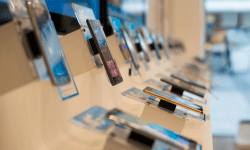 A ‘design patent’ is a monopoly granted by the government to make, use and sell a product having a particular appearance. Design patents protect how a product looks, not what it does. A person who copies a product protected by a patent, including a product protected by a design patent, will be ordered to stop infringing by a court only if the patent owner can demonstrate that the patent owner will suffer ‘irreparable harm’ due to the infringement that cannot be compensated by money damages. Such a court ‘injunction’ against an infringer is difficult to obtain under this standard.
A ‘design patent’ is a monopoly granted by the government to make, use and sell a product having a particular appearance. Design patents protect how a product looks, not what it does. A person who copies a product protected by a patent, including a product protected by a design patent, will be ordered to stop infringing by a court only if the patent owner can demonstrate that the patent owner will suffer ‘irreparable harm’ due to the infringement that cannot be compensated by money damages. Such a court ‘injunction’ against an infringer is difficult to obtain under this standard.
On the other hand, a ‘trademark’ indicates the source of a particular type of goods. If a trademark becomes ‘famous’ (for example, Coca-Cola®) then a court will order a trademark infringer not to use the famous trademark for other types of goods if the use will ‘dilute’ the famous trademark; that is, if the use will reduce the stature of the famous trademark in the eyes of the public. It is easier to obtain an injunction stopping infringement under the famous trademark standard than under the patent standard.
Apple and Samsung are in a worldwide battle over the alleged copying of Apple’s patented smartphone and tablet computer designs by Samsung. In a case before the Federal Circuit Court of Appeals, Apple argued that Samsung should be enjoined from selling its Galaxy smartphones because Samsung’s copying of the patented Apple design amounts to ‘design dilution.’ The argument is that Apple is ‘irreparably harmed’ for purposes of a preliminary injunction because Samsung’s product will ‘dilute’ the Apple design in the eyes of the public. This argument blends the trademark concept of dilution into patent law. The trial court rejected the argument for lack of evidence. The Federal Circuit affirmed the trial court’s conclusion that the argument was not supported by evidence, but concluded that it “would have been improper” to reject the argument outright. The Federal Circuit Court’s decision leaves Apple free to renew the argument with more evidence when the case comes to trial.
The Apple v Samsung case blurs the distinction between trademark and design patent law and potentially will ease the burden of a design patent owner in stopping an infringer.
— Robert Yarbrough, Esq.
*Originally posted on May 31, 2012

